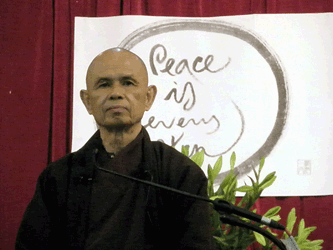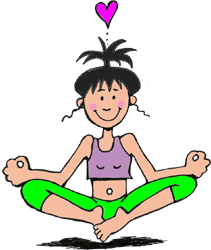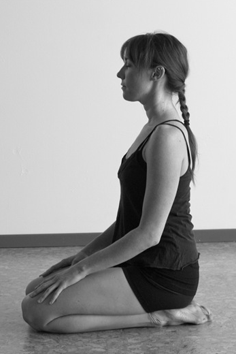By Bernie Clark, November 1st, 2017
Mindfulness is not for everybody
Repeat after me:
“I’m the only one!
There is something wrong with me.
I must be inadequate in some way.
Shanti, shanti, om…”
This wonderful little mantra was taught to me by Paul Grilley, who enlightened me about the reality and consequences of human variation. We are all unique: no one has your bones, or your body. It doesn’t take much reflection to understand the truth of this simple statement, but it took me long time to appreciate the breadth of its application. Of course we are all different, physically, but what about psychically? We know that not everyone can do every asana in the yoga vocabulary, but surely everybody can learn to meditate, right? Have you ever asked yourself, “Am I the only one who struggles with meditation?” If so, please repeat the mantra above, and read on.

According to the venerable Vietnamese Zen master Thich Nhat Hanh, “Mindfulness is the energy of being aware and awake to the present moment. It is the continuous practice of touching life deeply in every moment.”
The importance of contraindications
In yoga teacher training programs care is taken to make sure contraindications are known for postures that could be detrimental for some students. Teachers are taught to beware of inversions like headstand (Sirsasana) or shoulderstand (Salambasarvangasana) if the student has high blood pressure, an eye or ear infection, glaucoma, diabetes, etc. In these cases alternative postures may be offered that are not risky, such as simply having the legs up the wall (Viparitakarani). This is wise! It is good to know which postures may have a negative or unhealthy effect on certain students, and what to offer these students as an alternative. But, in my decades of taking a wide variety of yoga and meditation trainings, I do not recall hearing the teachers ever offering warning or advice about the negative impact of mindfulness or meditation training, let alone what a student should do if she did have a negative reaction to the practice. Perhaps because the negative affects of meditation are mostly psychological, they have been unrecognized, trivialized, minimized or the student marginalized instead of the problem being analyzed.
Early in my meditation practice I listened to students ask the teacher about their problems: sometimes the problems were related to improper technique; sometimes the problem was inadequate motivation; but sometimes the problems were more mysterious. I recall one student complaining that the student beside him was constantly leaning toward him, distracting him. The teacher explained that this was just “Makyō” – an illusion; the neighbor had not moved at all during the sitting.[1] She advised the student to just let the illusion be and return to awareness of the breath. Later, when I was the one leading meditation classes, students would often come to me with concerns about their practice: a few felt strange energy flows within them, or unusual emotional states, or achieved significant intellectual insights that would derail their intention of staying with the breath. These symptoms were rare, to be sure, but my response was identical to what my teachers had told me: these were either signs of the practice maturing, or the tricksy mind trying to avoid meditating. My response: “Don’t be bothered by these sensations: let them arise and let them pass.”
The reality of human variations
Paul Grilley and Sarah Powers showed me that I cannot treat each student in a yoga class as if they were are all the same. There is no one alignment cue that will work for every body and no body can do every pose in yoga. I buy into this totally: it makes perfect sense. And yet, in my meditation classes I still taught as if everyone was the same. I had not transferred Paul’s simple genius from the physical practice to the mental practice. I was focused purely on the benefits of a regular meditation practice, and on the large variety of techniques that can be used to create mindful experiences. One of the reasons that Yin Yoga resonates with me is the opportunity it provides to bring mindfulness into the practice. It was not until a few years ago that I awoke to the realization that here too, human variation rears its head. Not every body will benefit from mindfulness and not every body can meditate! And it is not because they are inadequate in some way.
I have to admit, there was a time in my yoga teaching when, if a student was not complying with my wonderful instructions, I really did think that there was something wrong with that student. Thanks to Paul and Sarah, I got over myself, and came to understand that every student has her own unique biology and biography. If she wasn’t doing what I suggested, it probably wasn’t because of a lack of interest, dedication or desire. What I was asking of her may have been inappropriate for her, and it was wisdom that prevented her from complying, not ignorance.
Meditation is not all sweetness and light[2]
 No asana works for every body and neither does meditation. A surprisingly large number or meditators experience mild, adverse effects. William James, the famous American psychologist turned spiritual investigator, noted as early as 1902 that some people have negative experiences from their spiritual practices. He did not conduct an exhaustive examination of this problem as his intention was to catalogue the vast range of religious experience, but he did cite two possible consequences of living a purely spiritual life: alienation and loneliness.[3]
No asana works for every body and neither does meditation. A surprisingly large number or meditators experience mild, adverse effects. William James, the famous American psychologist turned spiritual investigator, noted as early as 1902 that some people have negative experiences from their spiritual practices. He did not conduct an exhaustive examination of this problem as his intention was to catalogue the vast range of religious experience, but he did cite two possible consequences of living a purely spiritual life: alienation and loneliness.[3]
More recently, in 1992, a study found that 63% of Vipassana meditators had negative reactions to their practice, with 7% having significantly negative effects.[4] These included feelings of panic and anxiety, increased tension instead of being relaxed, a reduction in motivation, boredom, pain, confusion, feeling spaced-out and disoriented, impaired view of reality, feeling dissociated from their own bodies, depression and becoming addicted to their meditation practice. Two earlier studies in the 1980’s found that some meditators experienced weird and uncomfortable physical sensations, guilt, anxiety, psychosis-inducing thoughts, fear, anger, apprehension, despair, unwarranted elation, destructive behaviour and suicidal feelings.[5]
A study released in May of 2017 adds to the summary of the potentially negative affects of meditation.[6] The styles investigated included Zen, Tibetan and Theravada meditation. The negative experiences included hypersensitivity to light and sounds, insomnia, jerkiness and involuntary bodily movements, fear, anxiety, panic, or a complete inability to feel any emotions. These effects might last for days or for decades. As a result of these experiences some meditators felt disorientated, exposed or even violated. Even the meditators who had a “good” experience during a meditation retreat, and felt a sense of wholeness within themselves and with the world, found that when they returned to their daily life, their ability to function properly at work or with their family was impaired.
Wow! That is not what we expect to experience when we take up meditation, and to be clear, these negative affects do not happen to most people. But 7% means that 1 person in a class of 14 students may have some of these thoughts or feelings.[7] And yet, there is no training offered in yoga teacher trainings about how to deal with the students who is that 1 in 14. No contraindications are offered. It is as if the idea that mindfulness can be harmful has never occurred to yoga or meditation teachers. If a student does suffer from her practice, the common trope is to minimize her experience and pass it off as “nothing to worry about” or “it is all part of the process”. I offered these platitudes too, because my teachers offered them, as did their teachers. But, this is like saying to someone whose knees are burning while holding Lotus Pose, “just breathe, relax and engage mula bandha”. No! What they need is to come out of the pose and not do that pose anymore! The same advice should be offered to meditation student who find the practices disquieting.
Offering contra-indications
 Students are offered alternatives for posture that don’t work: instead of headstand, have your legs up the wall. Instead of Lotus, sit cross-legged. When an asana is risky, leave it out and adopt one that is not risky. The same process can work for pranayama or meditation practices. If a student has a negative reaction to any practice, alternatives should be offered. To be clear, the yoga teacher does not have to cure her student’s high blood pressure, diabetes or glaucoma! She just has to offer alternative postures that won’t negatively affect a student with those conditions. Similarly, if a student has a negative reaction to pranayama, mindfulness or meditation, the teacher does not have to become a psychotherapist and fix the student: she only needs to offer safer alternatives.
Students are offered alternatives for posture that don’t work: instead of headstand, have your legs up the wall. Instead of Lotus, sit cross-legged. When an asana is risky, leave it out and adopt one that is not risky. The same process can work for pranayama or meditation practices. If a student has a negative reaction to any practice, alternatives should be offered. To be clear, the yoga teacher does not have to cure her student’s high blood pressure, diabetes or glaucoma! She just has to offer alternative postures that won’t negatively affect a student with those conditions. Similarly, if a student has a negative reaction to pranayama, mindfulness or meditation, the teacher does not have to become a psychotherapist and fix the student: she only needs to offer safer alternatives.
The first step is to acknowledge that negative experiences can and do arise when students add meditation or mindfulness to their asana practice. Just as teachers warn students that inversions may not be a good idea for some students, students should also be warned that some forms of mindfulness may not be a good idea for some students. Let the student know that “she is not the only one!” If she does have a negative experience, she should tell the teacher so that other meditation techniques can be tried.[8] Or perhaps it is better not to meditate at all!
If you are a teacher, learn to acknowledge that a student reporting some adverse effect from being mindful or meditating is not “making stuff up.” There is nothing wrong with him or her. These negative experiences can happen to well-balanced, normal, psychologically healthy people. People vary dramatically, and while negative reactions are not the norm, they are not that rare: 1 person out 14 is not rare! This will happen to students you know and may have happened to you.
Avoiding the Doctor Yogi syndrome
The second step is to avoid the powerful urge to play doctor. Most yoga teachers have felt this temptation: a student comes up at the end of class to share a physical concern and asks for advice. Teachers want to be helpful, so the urge to say something is almost overwhelming, but teachers are not therapists. Even if one particular teacher is a doctor, a drop-in yoga class is no place to practice therapy: there is no time to do a full interview of the student or run any tests to seek confirmation of diagnoses. It is inappropriate for a yoga teacher to offer medical advice. This is fairly common wisdom, and it applies just as strongly to psychological advice. If a student is experiencing any negative effect from mediation, mindfulness, pranayama, chanting, or any of the other psychological tools employed in yoga, the teacher must resist playing psychotherapist. Just as she would for a student citing a physical complaint, if the condition persists, suggest she have it checked out.
In short
Meditation and mindfulness practices can be healing and wholesome for most people. Our yoga practice is a wonderful time to engage in these exercises. The benefits easily carry over into everyday life. But, please be aware that for some people, the magic is missing and the promised positive experiences do not appear. Instead confusing negative experiences arise. The student, thinking that meditation is always good, starts to doubt her own inner wisdom and thinks, “There something wrong with me!” No, she is fine. She is just different.
And if this is you, that’s okay.
Footnotes:
- — Makyō refers to the hallucinations and perceptual distortions that can arise during the course of meditation and can be mistaken by the practitioner as “seeing the true nature” or kenshō. Zen masters warn their meditating students to ignore sensory distortions. Description is from Wikipedia
- — See Megan Brooks article Meditation is not all sweetness and light in Medscape, May 25, 2017.
- — See The Varieties of Religious Experience by William James, published by CreateSpace Independent Publishing Platform (March 11, 2013).
- — See Shapiro DH “Adverse effects of meditation: a preliminary investigation of long-term meditators” in Int J Psychosom 1992;39 (1-4):62-7.
- — See Craven JL “Meditation and Psychotherapy” in Canadian Journal of Psychiatry, Volume: 34 issue: 7, page(s): 648-653 October 1, 1989
- — See Jared R. Lindahl et al., “The varieties of contemplative experience: A mixed-methods study of meditation-related challenges in Western Buddhists” published in PLOS One published: May 24, 2017.
- — See Alberto Perez-De-Abeniz and Jeremy Holmes, “Meditation: Concepts, Effects and Uses in Therapy” in International Journal of Psychotherapy, March 2000, Vol. 5 Issue 1, p49, 10p.
- — Josh Summers advocates a different approach that may be more appropriate than standard mindfulness techniques. He calls it “Yin meditation”. See his podcasts.
